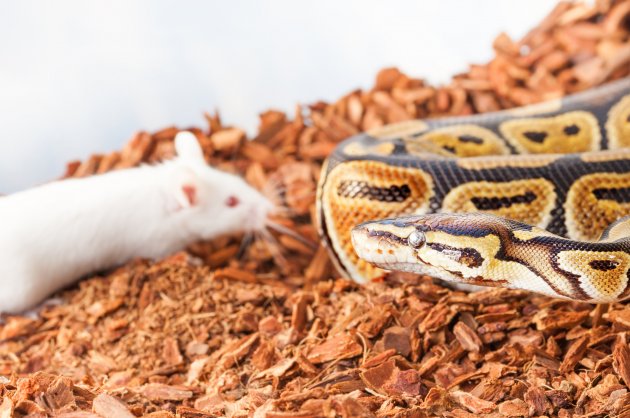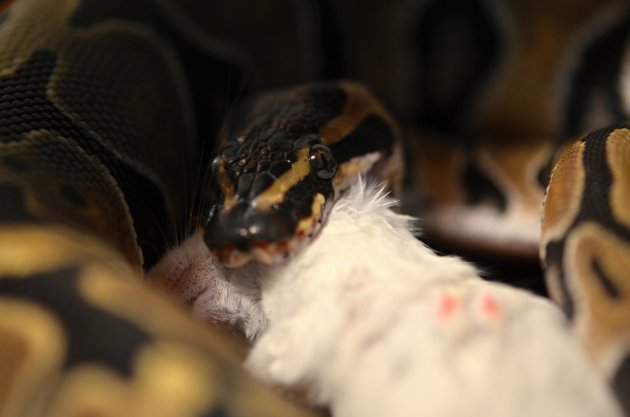You will often see people asking; why is my ball python not eating? Or baby ball python not eating, and ball python not eating for months, etc. Truth is, adult ball pythons, that is one year old plus, can usually go for a while (10-14 days) till their next meal.
However, it’s not uncommon to hear that a healthy ball python has gone for months without eating. This is because they have enough body fat to keep them going without starving. But, if your ball python goes longer than that without eating, start monitoring it to see if you notice anything different; especially weight loss.

Here are some of the possible reasons why your ball python won’t eat:
1. Wrong food choice, or wrong feeding time
What to feed a ball python? What do ball pythons eat?
First, you need to know your ball python’s history; its place of origin, was it wild-caught? What has it been eating before? How often was it eating? Does it have a favorite prey?
If your ball python was wild-caught, then it is automatically a nocturnal predator. And, you might have a hard time providing it with something similar or close to what it was used to feeding on in the wild.
But, wild-caught ball pythons do well with gerbils, brown mice, hamsters, etc. They might not eat the common white rodents.
Again, your ball python will not eat cold or frozen rodents. Thaw them then offer them when warm.
When to feed a ball python?
Ball pythons are nocturnal, and as such, they will come out to play at night and that’s when they will eat. And, feeding your ball python in the dark does not equate to feeding them at night. You should offer them the food at night.
Again, ball pythons are shy pets. They might not eat when you’re around. So, just get them the prey then give them space.
And, do you need a separate feeding enclosure for your ball python? This depends on what your pet is used to. If he is used to feeding in his normal enclosure, then taking him out to a different place to feed might leave him confused and cause him to refuse to eat. On the other hand, if your ball python is used to feeding in a different enclosure, you need to offer him the same.
2. Illness (intestinal parasites or physical problems)
First, maybe the reason why your ball python won’t eat is because he is constipated. Mostly, a constipated ball python may refuse to eat anything you offer him until his stomach is clear of their last meal.
Now, what causes constipation for ball pythons?
The meal size. If you are feeding your ball python too large of rodents or whatever, that might result in them being constipated. Their biggest meal should be around the size of the widest part of your ball python. Too large of prey might get stuck in the oesophagus or cause constipation.
Another cause of constipation for ball pythons is having them in a too dry or too hot enclosure. Your pet might also be having some intestinal issues, so if you rule everything out and they are still constipated, make an appointment with your vet for a test.
How do you help a constipated ball python? – Relieving ball python constipation.
You can start by soaking your ball python in some warm water for around fifteen minutes. This will help by softening any feces that might be blocking the exit; thus allowing the whole waste to pass.
Second, ensure that their enclosure has the right temperatures - 75 degrees at night, then 85-90 degrees during the day. They should also have a 95 degree focal hot spot, and 70-80 percent relative humidity.
See other people’s experiences with ball python constipation and how they dealt with it.
You can only know if your ball python has intestinal parasites after visiting a vet. Thus, if you try everything without success, make that appointment.
3. Stress and improper cage set up
If you recently got your ball python, it might be stressed out from the changes. You can give it a few days to adjust then try feeding it again.
Also, if you recently traveled with your pet, the trip might have taken a toll on it and it needs time to relax.
Again, has your ball python been handled too much recently? Ball pythons are shy pets, and even though they are harmless and cute, they don’t like to be handled a lot. If this is the case, you can let it have its space for a few days then try feeding it.
Lastly, how is its enclosure? Is it in the recommended condition for ball pythons? Does it have a hiding place? If you put your ball python in the wrong environment, it’s going to be stressed out and it might not eat.
A ball python cage set up should be warm and dark with hiding places. Remember that ball pythons are nocturnal.
4. Going into or already in a shed cycle
If your ball python is going into or already is in a shed cycle, then it won’t eat until it’s done shedding all that old skin.
To know if your snake is getting into a shed cycle, look at their skin keenly. If they have milky eyes and ashy appearances on the skin, then that should explain why they are not eating.
5. Seasonal fasting period
Could your ball python be going through a seasonal fasting period? This happens between November and April, as it is the winter breeding season. This is what some call the seasonal changes in feeding behavior for ball pythons.
6. Sexual maturity
The female ball pythons will go into fasting when developing and holding eggs, gravid. This goes on even when brooding eggs. This can happen when your female ball python is two year old.
For male ball pythons, their sexual maturity might come in sooner.

What to do when a ball python won’t eat
We have mentioned most of what you should do when your snake won’t eat in the points above, but we’d like to add the last resort.
If you have offered your ball python a frozen and thawed rodent, rechecked the prey size to ensure that it’s the right size for them, offered the meal at night and in the right environment and temperature, left it alone for some days then offered a meal again and still he won’t eat, now it’s time for the three last attempts.
First, take your ball python to a herp veterinarian to rule out any parasite infestation or any low-grade bacterial infections.
If all is good, proceed to the next step which is offering it a freshly killed rodent or a mouse scented with gerbil litter. You can easily do this in your local pet stores.
The very last thing to offer your ball python if nothing else works is a live rodent. Now, this is highly discouraged, but if worse comes to worst, you can try it and see if they will get back to their feeding routine.
However, do not leave your snake in a cage with a live rodent unattended. Remember these are two primarily wild species, and things can turn ugly in no time. If your snake refuses to eat the live rodent, take the rodent out of the cage.
Lastly, you can also give it a humanely killed gerbil, and if it refuses to eat that too, try a live gerbil. Ball pythons love gerbils, but you don’t want them to get used to eating them. Thus, this should only happen if every other recommendation bears no fruits. All the best!
Further reading and references:
- ScienceDaily. How Snakes Survive Starvation
- ScienceDirect. Spatial considerations for captive snakes
- Veterinary Medicine at Illinois. Pet Snakes Should Be Fed Pre-Killed Diet
- The Ball Street Journal. Justin Kobylka. The Psychology of Problem Feeders – Get your Ball Python eating again